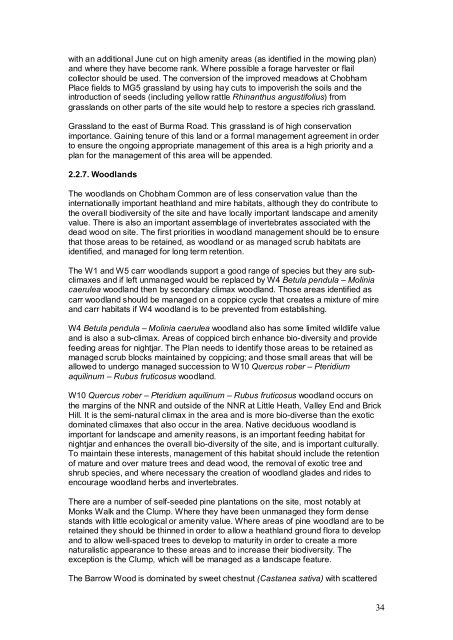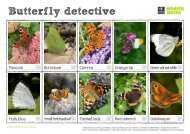CHOBHAM COMMON NNR - Surrey Wildlife Trust
CHOBHAM COMMON NNR - Surrey Wildlife Trust
CHOBHAM COMMON NNR - Surrey Wildlife Trust
You also want an ePaper? Increase the reach of your titles
YUMPU automatically turns print PDFs into web optimized ePapers that Google loves.
with an additional June cut on high amenity areas (as identified in the mowing plan)<br />
and where they have become rank. Where possible a forage harvester or flail<br />
collector should be used. The conversion of the improved meadows at Chobham<br />
Place fields to MG5 grassland by using hay cuts to impoverish the soils and the<br />
introduction of seeds (including yellow rattle Rhinanthus angustifolius) from<br />
grasslands on other parts of the site would help to restore a species rich grassland.<br />
Grassland to the east of Burma Road. This grassland is of high conservation<br />
importance. Gaining tenure of this land or a formal management agreement in order<br />
to ensure the ongoing appropriate management of this area is a high priority and a<br />
plan for the management of this area will be appended.<br />
2.2.7. Woodlands<br />
The woodlands on Chobham Common are of less conservation value than the<br />
internationally important heathland and mire habitats, although they do contribute to<br />
the overall biodiversity of the site and have locally important landscape and amenity<br />
value. There is also an important assemblage of invertebrates associated with the<br />
dead wood on site. The first priorities in woodland management should be to ensure<br />
that those areas to be retained, as woodland or as managed scrub habitats are<br />
identified, and managed for long term retention.<br />
The W1 and W5 carr woodlands support a good range of species but they are subclimaxes<br />
and if left unmanaged would be replaced by W4 Betula pendula – Molinia<br />
caerulea woodland then by secondary climax woodland. Those areas identified as<br />
carr woodland should be managed on a coppice cycle that creates a mixture of mire<br />
and carr habitats if W4 woodland is to be prevented from establishing.<br />
W4 Betula pendula – Molinia caerulea woodland also has some limited wildlife value<br />
and is also a sub-climax. Areas of coppiced birch enhance bio-diversity and provide<br />
feeding areas for nightjar. The Plan needs to identify those areas to be retained as<br />
managed scrub blocks maintained by coppicing; and those small areas that will be<br />
allowed to undergo managed succession to W10 Quercus rober – Pteridium<br />
aquilinum – Rubus fruticosus woodland.<br />
W10 Quercus rober – Pteridium aquilinum – Rubus fruticosus woodland occurs on<br />
the margins of the <strong>NNR</strong> and outside of the <strong>NNR</strong> at Little Heath, Valley End and Brick<br />
Hill. It is the semi-natural climax in the area and is more bio-diverse than the exotic<br />
dominated climaxes that also occur in the area. Native deciduous woodland is<br />
important for landscape and amenity reasons, is an important feeding habitat for<br />
nightjar and enhances the overall bio-diversity of the site, and is important culturally.<br />
To maintain these interests, management of this habitat should include the retention<br />
of mature and over mature trees and dead wood, the removal of exotic tree and<br />
shrub species, and where necessary the creation of woodland glades and rides to<br />
encourage woodland herbs and invertebrates.<br />
There are a number of self-seeded pine plantations on the site, most notably at<br />
Monks Walk and the Clump. Where they have been unmanaged they form dense<br />
stands with little ecological or amenity value. Where areas of pine woodland are to be<br />
retained they should be thinned in order to allow a heathland ground flora to develop<br />
and to allow well-spaced trees to develop to maturity in order to create a more<br />
naturalistic appearance to these areas and to increase their biodiversity. The<br />
exception is the Clump, which will be managed as a landscape feature.<br />
The Barrow Wood is dominated by sweet chestnut (Castanea sativa) with scattered<br />
34



![Thursley Common [Shrike Hill] (SU9041) & Sheets Heath (SU9457 ...](https://img.yumpu.com/11846073/1/184x260/thursley-common-shrike-hill-su9041-sheets-heath-su9457-.jpg?quality=85)

